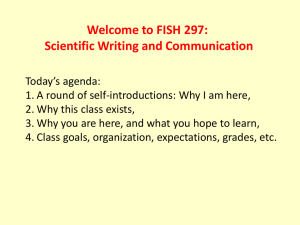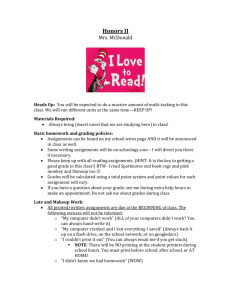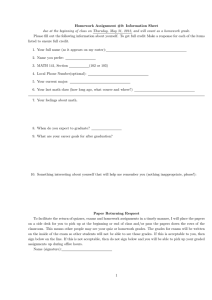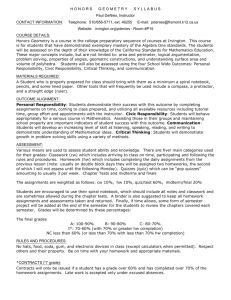Suzy Q November 10, 2010
advertisement
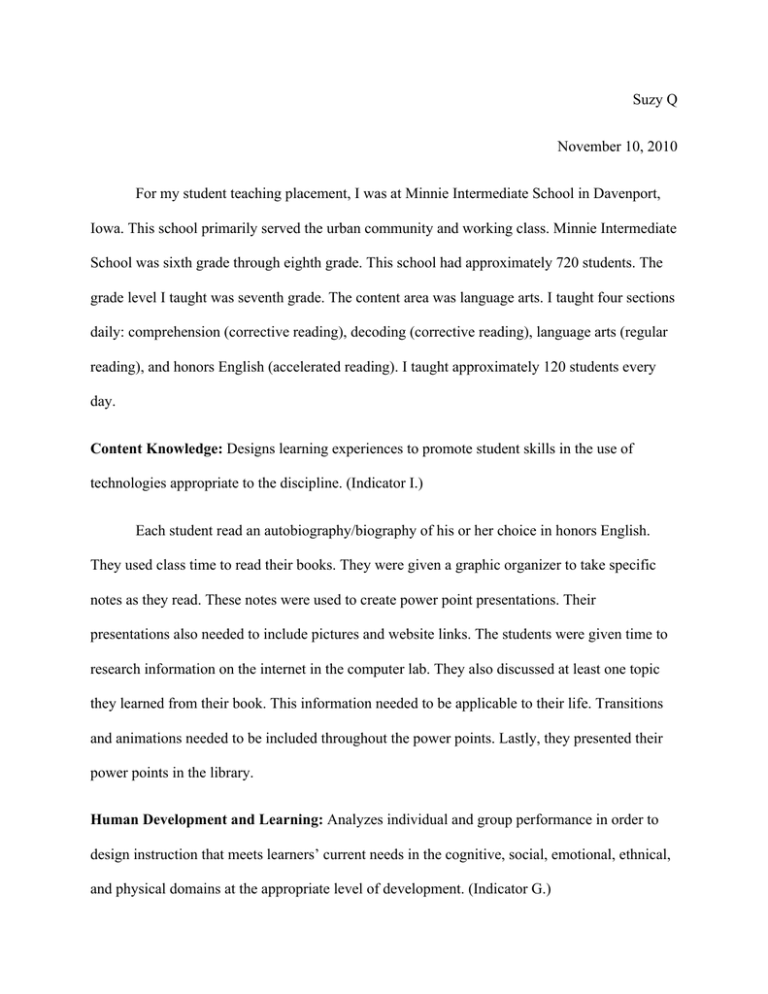
Suzy Q November 10, 2010 For my student teaching placement, I was at Minnie Intermediate School in Davenport, Iowa. This school primarily served the urban community and working class. Minnie Intermediate School was sixth grade through eighth grade. This school had approximately 720 students. The grade level I taught was seventh grade. The content area was language arts. I taught four sections daily: comprehension (corrective reading), decoding (corrective reading), language arts (regular reading), and honors English (accelerated reading). I taught approximately 120 students every day. Content Knowledge: Designs learning experiences to promote student skills in the use of technologies appropriate to the discipline. (Indicator I.) Each student read an autobiography/biography of his or her choice in honors English. They used class time to read their books. They were given a graphic organizer to take specific notes as they read. These notes were used to create power point presentations. Their presentations also needed to include pictures and website links. The students were given time to research information on the internet in the computer lab. They also discussed at least one topic they learned from their book. This information needed to be applicable to their life. Transitions and animations needed to be included throughout the power points. Lastly, they presented their power points in the library. Human Development and Learning: Analyzes individual and group performance in order to design instruction that meets learners’ current needs in the cognitive, social, emotional, ethnical, and physical domains at the appropriate level of development. (Indicator G.) A lesson in comprehension class began with oral work. I started the lesson by asking questions about the body system. I called on individual students for answers. Most of the students struggled with their responses. I drew a diagram on the board which coincided with the discussion. After discussing the key elements of the diagram, the students were able to answer the questions correctly. Next, the students used the remainder of the class period to complete their workbook. As they worked, I walked around the classroom and helped individual students as needed. For one student, I read the questions out loud to him while he followed along. He responded by telling me the answers. He then wrote his answers in his workbook. Diversity: Uses a wide range of instructional strategies and technologies to meet and enhance diverse student needs. (Indicator K.) The students in language arts completed a lesson about the Titanic. This lesson began in the library. I used video clips and pictures to grab the attention of the students. Each video clip and picture was discussed as a class. This allowed the students to share their thoughts, opinions, and ideas. This also allowed the students to learn from one another. Next, they listened to a story about the Titanic on tape. They also followed along in their book. I stopped the story occasionally to discuss important events. After listening to the story, the students wrote a short story. They pretended they were a passenger on board the ship. Planning for Instruction: Creates short-range and long-term plans to achieve the expectations for students’ learning. (Indicator K.) In language arts, the students were given three weeks of class time to work on their compare/contrast papers. This was the first formal paper of the school year. To help the students write their paper, the writing process was broken down into individual steps. First, they brainstormed ideas as a class. Next, the students created questions to ask their mom or dad. Then they used their answers to complete a point-by-point organization worksheet. After that, the students wrote their rough drafts. Following this, they responded to their work. The students also needed a peer in the classroom to respond to their work. Next, the students rewrote their papers. After that, they edited their papers. They also needed a peer in the classroom to edit their work. Lastly, the students typed their final copy of their papers in the computer lab. Learning Environment: Organizes, allocates, and manages time, materials, and physical space to provide active and equitable engagement of students in productive tasks. (Indicator M.) Honors English used class time to create their group philosophy presentations. Before letting the students work on their assignments, I showed multiple examples from previous honors English classes. As a class, we discussed key elements on the poster board. We also discussed ways to grab the attention of the audience. For this assignment, the students brought in their own poster boards and materials. I also provided materials for them to use. The students were allowed to move their desks around the room to provide maximum working space. If needed, the students used the computer in the classroom to type information for their presentations. They were given three class periods to complete this assignment. The back counter in the classroom was used to store poster boards and materials in between classes. If the students did not finish their poster boards in class, they took them home and brought them back the following day. Lastly, the students presented their poster boards to the class. Instructional Delivery: Uses multiple teaching and learning strategies to engage students in active learning opportunities that promote the development of critical thinking, problem-solving, and performance capabilities and that help students assume responsibility for identifying and using learning resources. (Indicator G.) In language arts the students were assigned a character suitcase book project. First, I gave each student a copy of the directions and rubric. I discussed each part of the project in detail. The students were allowed to pick any book of their choice, as long as it was more than one hundred pages. They then needed to create a suitcase out of a box for a character in their book. This box needed to be decorated according to the characteristics of the chosen character. Furthermore, the students needed to pick a destination for their character to go to. Based on the character, the students needed to fill their suitcases with ten items. These items needed to be both tangible and intangible. The students were given two weeks to work on this project outside of class. I explained to the students that I was available both before and after school if they needed assistance. This project was then presented in front of the class. For the presentations, the students took the role of their chosen character. They explained their decorated suitcase and each item in their suitcase. Communication: Creates varied opportunities for all students to use effective written, verbal, non-verbal, and visual communication. (Indicator G.) At the beginning of the year, the students put together a vocabulary packet. Vocabulary words from the textbook and curriculum guide were defined in this packet. As the teacher, I helped the students define these words. First, I wrote a vocabulary word on the board. As a class, they discussed the meaning of the word. The students used this information to create their own personalized definitions. This allowed the students to take ownership of the word. Next, they discussed pictures that could be drawn to represent the definition. As the students discussed their ideas, I drew them on the board. Lastly, they discussed reminder words. These words were synonyms for the word being defined. I also wrote these words on the board. Every word in the vocabulary packet was defined this way. Assessment: Maintains useful and accurate records of students’ work and performance and communicates students’ progress knowledgeably and responsibly to students’, parents, and colleagues. (Indicator L.) In decoding class, I tracked the progress of the students daily. First, I graded them on their oral work. The students earned points for reading words from their textbook correctly. If words were missed, they did not earn points. Next, the students read a short story from their book. Each student read two sentences at a time. These sentences were read out loud. Other students used their fingers to track in their textbook. Students earned points for making no more than two errors for every section of the story. After the story, the students completed two reading checkouts. Lastly, the students were given ten minutes to complete their workbook lesson. After grading the workbooks as a class, I gathered points from the students. I recorded these points in the grade book. I then transferred these grades to the on-line grade book. Parents were able to check these grades on-line. I discussed student progress with each student after every five lessons. The students were able to come in either before or after school for extra support or assistance. Collaborative Relationships: Demonstrates the ability to co-teach and co-plan. (Indicator S.) My fourth period language arts class was co-taught with the seventh grade resource teacher. I met with this teacher before every class period. At that time, we discussed the daily lesson plan. For one lesson, the students were learning how to use the apostrophe correctly. First, as a class, we discussed and completed examples together. He also provided examples and asked questions. Next, the students were given worksheets to complete individually. Once the students were given their worksheets, he took his eight resource students to his classroom. This allowed him to work individually with each student. He also differentiated the lesson according to the individual needs of the students. The rest of the students remained in the classroom with me. I walked around the classroom and helped these students as needed. Reflection and Professional Growth: Collaborates with other professionals as resources for problem-solving, generating new ideas, sharing experiences, and seeking and giving feedback. (Indicator F.) I had classroom management issues with my sixth period language arts class. Many students were talkative and disruptive. I discussed this problem with my mentor teacher. After discussing various strategies, I implemented positive reinforcement into the daily lesson plans. Instead of focusing on the disruptive students, I recognized the students who were following the classroom rules and directions. This strategy proved to be beneficial and rewarding. Sharing ideas and seeking feedback allowed me to improve on my teaching practices. Professional Conduct: Actively participates in or leads in such activities as curriculum development, staff development, and student organizations. (Indicator M.) My mentor teacher was in charge of the school yearbook. The yearbook club was open to all students at the school. During the second week of school, a meeting was held after school. I prepared for this meeting by making signs. I posted those signs on the walls around the building. At that meeting, upcoming school events were discussed. My mentor teacher and I organized a chart with a list of events that needed to be covered by a specific deadline. I took pictures at Minnie’s field day. Collaboration: Shares information and materials with others. I taught a unit on point of view and characterization. I met with the other seventh grade language arts teacher several times. At our first meeting, we looked through the information we needed to cover in the textbook. Based on this information, we created a pre-test for the students to take. Using this data, we planned to teach one week for each objective. We also brainstormed activities that students were interested in. Since I was having difficulty creating lessons on characterization, she helped to come up with activities I could incorporate into the lesson plans. In return, I shared point of view lessons with her. Honesty/Integrity: Acts with honesty and integrity in all academic and professional situations. New grades were posted for every class at the end of every week. If students were failing, I highlighted their student identification number and their overall percentage. After looking over the grades one Friday, I noticed many students were failing to complete their assignments. I decided to incorporate a discussion about responsibility into the lessons. It was important for the students to understand that missing assignments resulted in lower grades. I briefly went over the details of the assignments again with the students. I also explained that all late work was still acceptable for points. Students were also aware that they could come in either before or after school for assistance. Respect: Takes care of property of others in all academic and professional situations. While teaching, I maintained the upkeep of the classroom. All borrowed materials were returned to their proper place. At the end of the day, I also picked up the classroom and kept it orderly. Throughout the school day, I sometimes needed to remind the students to sit in their desks properly. If mistreated and misused, the desks were easily damaged. If I left the classroom I locked the classroom door. This prevented students from wandering into the empty classroom. Commitment to Learning: Seeks opportunities to learn new skills. At the end of my student teaching experience, I observed other teachers in the building. This allowed me to recognize other teaching styles and strategies. The teachers that I observed had different openers and early finish activities. Technology was incorporated into many of the lessons. The lessons were more engaging and interesting with the incorporation of technology. I also focused on classroom management techniques. One common technique that I observed was sending a disruptive student to a different classroom. This was known as a class-out punishment. The student was given work to complete during this time. As I observed, I took notes on the ideas, strategies, and techniques I liked. Emotional Maturity: Adapts to unexpected or new situations. For one lesson, the students in honors English met in the library. They were going to finish presenting their power point presentations. However, another teacher signed up to use the library without my knowledge. In return, I signed the class up to use the library the following day. Furthermore, the students returned to the classroom. To adapt to this situation, I followed through with the next day’s lesson. First, the students wrote in their journal as an opener. Then, as a class, we discussed three new vocabulary words. These words were added to their vocabulary packets. Responsibility: Manages time effectively. Language arts and honors English classes began with a daily opener. The students were given approximately five to ten minutes to complete this task. At this time, I took attendance and prepared for the daily lesson. After the opener, I transitioned directly into the lesson. I continued the lesson until the last five minutes of class. The students used this time to return any used materials. They also gathered their belongings for their transition to their next class. These five minutes allowed me to switch materials for the next class period. Fairness: Considers opinions of others with an open mind. During my student teaching experience, I had the opportunity to work with a few substitute teachers. As I taught the daily lessons, they sat at the back desk and observed. At the end of every class, we discussed strengths and areas of improvement. This allowed me to gather multiple perspectives about how to improve my teaching. They also discussed their substitute teaching experiences. This was beneficial because I learned about other schools in the district. Belief that All Students Can Learn: Appreciates and embraces individual differences. For a lesson in language arts, the students discussed their dreams and goals. First, the students wrote in their journal. Next, the students shared their dreams and goals with the class. Lastly, they discussed obstacles they needed to overcome in order to reach their goals. This lesson taught the students that everyone was different. Some students had dreams of becoming famous athletes and celebrities, where as other students has dreams of becoming veterinarians and lawyers. Every student realized that there were steps they needed to conquer before reaching their ultimate goal. Strength: Returning assignments in a timely and organized manner. Every class had a bin assigned for homework. I checked this bin everyday for turned in assignments. If I had papers to grade, I took them home and graded them overnight. If assignments were late, I wrote that on their papers. I also recorded those grades in the grade book. In the mornings, I returned the homework to the bins. Each student had a folder that was used for returned assignments. They checked those folders at the beginning of every class period. Strength: Being prepared for every lesson. I began every morning by writing the daily agenda on the board. Then, I gathered all the materials I needed for the lessons. For one lesson, I prepared by reading through one of the stories in the textbook. As I read, I took notes about important events in the story. These events were discussed in detail as a class. I also wrote down a variety of questions to ask the students. Before reading the story, I asked the students to share their memories of kindergarten. I used their examples to connect to the story. This gave the students a purpose for reading. Weakness: Incorporating technology into the daily lesson plans. I found incorporating technology into the daily lesson plans very difficult. The only source of technology in the room was the teacher’s computer. It was difficult to incorporate technology because of the location of the room. The room was set in between two flights of stairs. This room was not on one of the main floors. This meant that I could not use any of the technology carts that were available in the library. If I included technology into a lesson, I signed up in advance to use the library. I did this as often as I could. I also used the computer lab for various lessons. Weakness: Keeping all students are on task during a lesson. While teaching a lesson in language arts, I realized many students were off task. When I began the lesson, I asked the students to focus their attention to the front of the classroom. I introduced the five stages of plot. Soon after, I realized some students were not paying attention. Immediately I stopped the lesson. I explained that all materials needed to be placed under the desks except for the literature books. Their literature book needed to be opened to a specific page. The students were not allowed to work on other homework assignments. They were also not allowed to read their library books. Throughout the rest of the lesson, I engaged the students in discussions. I also walked around the classroom to keep the students alert and on task. Student teaching was a rewarding experience. I enjoyed teaching seventh grade at Minnie Intermediate School. I discovered my strengths and weaknesses as a beginner teacher. I learned that the enthusiasm in the classroom starts with me. It is also a commitment that lasts longer the typical workday. I also found that certain skills take time and practice, such as classroom management. Overall, I could not have asked for a better student teaching placement.
